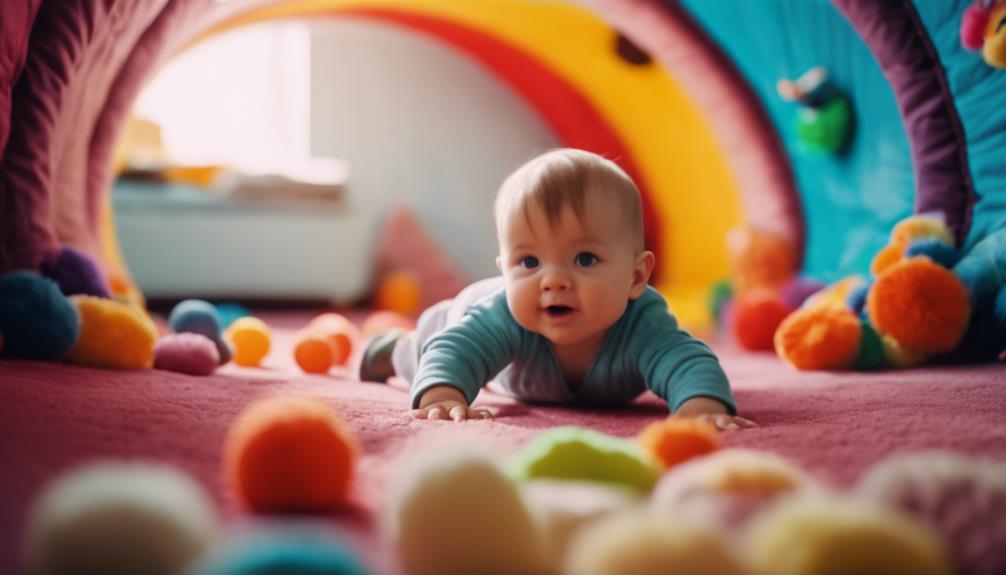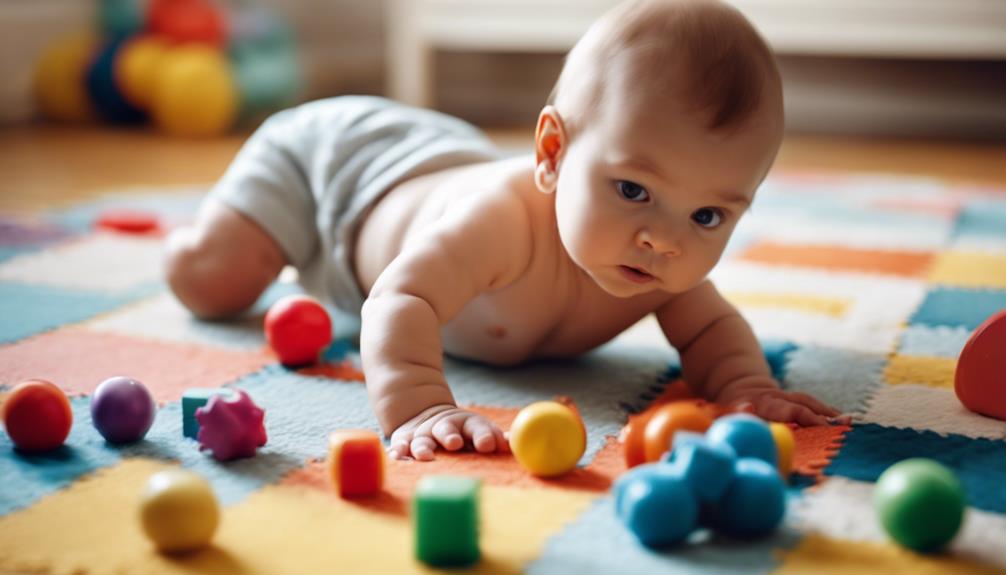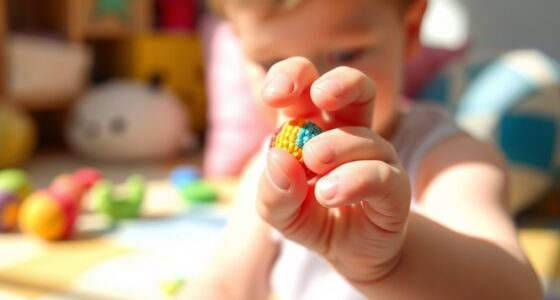Encourage your baby to move by focusing on activities such as tummy time to help strengthen muscles and improve coordination. Use toys that encourage reaching and grasping to enhance fine motor skills. Engage in music and interactive games like peek-a-boo to support gross motor skills and social development. Create a movement-friendly environment by setting up obstacle courses and play areas with interactive toys within reach. Support sitting activities to help reach developmental milestones. Starting purposeful physical activities early will help build a strong foundation for your baby’s motor skills. More valuable insights are waiting for you on this important journey.
Key Takeaways
- Initiate tummy time early to promote muscle strength.
- Use interactive toys and games to encourage movement.
- Incorporate music for gross motor skill development.
- Create a safe play environment for exploration.
- Support sitting activities for milestone achievements.
Importance of Baby Physical Activities
Regular physical activity is essential for newborns and infants to develop essential muscles for movement like sitting up, crawling, and walking. Encouraging physical activity in babies is important for their overall development, particularly in enhancing motor skills.
Activities such as tummy time play a significant role in helping infants strengthen their muscles and improve coordination. By providing ample opportunities for infants to engage in reaching, grabbing, and exploring objects, caregivers can support the development of their motor skills.
It's necessary to create a safe and stimulating environment that promotes physical activity for infants and toddlers. Interacting with the environment beyond devices like strollers or carriers allows babies to build strength and coordination effectively.
Daily floor play activities not only encourage movement but also aid in the overall physical development of infants. Therefore, incorporating various forms of physical activity into a baby's routine is fundamental for fostering their growth and motor skill acquisition.
Developmental Milestones in Infant Movement
Infant movement development progresses through key milestones during the first year of life, starting with lifting the head during tummy time in the initial months. As your baby grows, you may notice exciting changes in their motor skills. Around 3-6 months, infants often start reaching for toys and mastering the art of rolling over during tummy time. By the age of 6-9 months, your little one might surprise you by rolling from tummy to back and even pushing up on their hands and knees. As they approach 9-12 months, crawling, pulling to stand, and playing using both hands become important for your baby's overall physical development. Encouraging play during tummy time can help strengthen their muscles and improve coordination. Below is a table summarizing the typical developmental milestones in infant movement:
| Age Range | Developmental Milestones |
|---|---|
| 0-3 months | Lifting head during tummy time |
| 3-6 months | Reaching for toys, rolling over during tummy time |
| 6-9 months | Rolling from tummy to back, pushing up on hands and knees |
| 9-12 months | Crawling, pulling to stand, playing with both hands |
Effective Tummy Time Techniques

Consider incorporating tummy time techniques early on to support your baby's physical development. The Department of Health recommends starting with short periods of tummy time, a few minutes at a time, several times throughout the day. This practice helps strengthen your infant's neck, head, and upper body muscles, important for achieving developmental milestones in motor skills.
If traditional tummy time poses challenges, alternatives like tummy time on your chest or lap can also be beneficial.
During tummy time, make sure to engage with your baby, encouraging them to reach and explore their surroundings. This interaction not only fosters movement but also promotes bonding between you and your little one.
Remember to gradually increase the duration of tummy time as your baby grows stronger, providing breaks as needed to guarantee their comfort. Early intervention through consistent tummy time can make a significant difference in your baby's physical development.
Fun Play Ideas for Encouraging Movement

To encourage movement in your baby, try incorporating fun play ideas that stimulate both physical and social development. Engage in activities that promote fine motor skills, such as using toys that encourage reaching and grasping. Play music and encourage your baby to sway, kick, and clap to the beat to enhance gross motor skills. Interactive games like peek-a-boo and patty-cake not only foster social development but also encourage physical movement. Create obstacle courses using pillows or cushions to stimulate crawling and exploration. Additionally, offer sensory play experiences with textured balls or fabric to promote sensory development.
Consider the following table for more play ideas:
| Play Idea | Description |
|---|---|
| Music and Movement | Encourage your baby to sway, kick, and clap to the beat of music to enhance gross motor skills. |
| Fine Motor Toys | Use toys that promote reaching, grasping, and kicking to enhance fine motor skills. |
| Interactive Play | Engage in games like peek-a-boo or patty-cake to encourage both social and physical development. |
| Obstacle Courses | Create courses using pillows or cushions to stimulate crawling and exploration. |
| Sensory Play | Offer sensory experiences with items like textured balls or fabric to promote sensory development. |
Creating a Movement-Friendly Environment

Make sure your home is a safe and engaging environment that promotes movement and exploration for your baby. Encouraging tummy time is essential for building muscle strength and developing motor skills.
Create a designated play space with interactive toys and objects within your baby's reach to encourage movement exploration. As your baby progresses, support sitting activities to help them reach developmental milestones like sitting and standing.
Stay close by to provide security as your little one explores their surroundings and practices new movements. Remember to implement safety measures such as using gates and locks to guarantee a secure environment for mobile infants.
Frequently Asked Questions
How to Encourage a Baby to Be More Active?
To encourage your baby to be more active, engage in tummy time, place toys within reach for reaching and grasping, create a safe and stimulating environment, interact during play, and establish a routine with movement opportunities.
What Activities Encourage Physical Development in Infants?
You can boost physical development in infants through interactive play, engaging toys, and safe environments. Embrace tummy time for muscle strength and floor play for exploration. Strategically position toys to support rolling over and reaching milestones.
What Type of Physical Activity Is Recommended for Infants?
For infants, supervised tummy time, reaching, grasping, and rolling activities are recommended to enhance physical development. Engaging in safe floor play, exploring with caregivers, and providing age-appropriate toys support motor skills and mobility.
How to Encourage a Baby to Push Up?
Want to encourage your baby to push up? Start by placing toys just out of reach during tummy time. Use colorful toys, offer verbal support, and gradually increase tummy time sessions. Celebrate their progress with praise!
Conclusion
To sum up, engaging in physical activities with your baby is crucial for their overall development. By incorporating effective tummy time techniques and fun play ideas, you can encourage movement and help them reach important developmental milestones.
Remember, a baby on the move is like a blossoming flower in a gentle breeze – full of vitality and growth. So, create a movement-friendly environment and watch your little one thrive.










